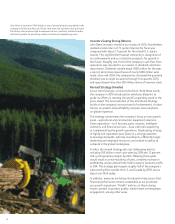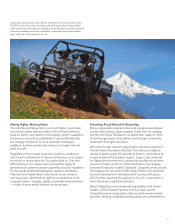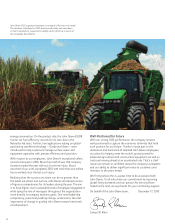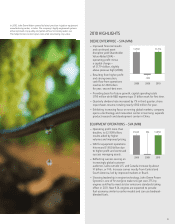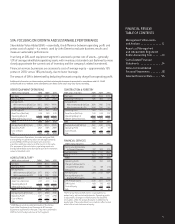John Deere 2010 Annual Report Download - page 15
Download and view the complete annual report
Please find page 15 of the 2010 John Deere annual report below. You can navigate through the pages in the report by either clicking on the pages listed below, or by using the keyword search tool below to find specific information within the annual report.
15
All of the company’s businesses and its reported results are
affected by general economic conditions in the global markets
in which the company operates, especially material changes in
economic activity in these markets; customer confi dence in
general economic conditions; foreign currency exchange rates,
especially fl uctuations in the value of the U.S. dollar; interest
rates; and infl ation and defl ation rates. General economic
conditions can affect demand for the company’s equipment as
well. The current economic conditions and outlook in certain
sectors have dampened demand for certain equipment.
Customer and company operations and results could be
affected by changes in weather patterns; the political and social
stability of the global markets in which the company operates;
the effects of, or response to, terrorism and security threats
(including those in Mexico); wars and other confl icts and the
threat thereof; and the spread of major epidemics (including
H1N1 and other infl uenzas).
Signifi cant changes in market liquidity conditions could
impact access to funding and associated funding costs, which
could reduce the company’s earnings and cash fl ows.
Market conditions could also negatively impact customer access
to capital for purchases of the company’s products; borrowing
and repayment practices; and the number and size of customer
loan delinquencies and defaults. A sovereign debt crisis, in
Europe or elsewhere, could negatively impact currencies,
global fi nancial markets, social and political stability, funding
sources and costs, customers, and company operations and
results. State debt crises also could negatively impact customers,
suppliers, demand for equipment, and company operations and
results. The company’s investment management activities could
be impaired by changes in the equity and bond markets, which
would negatively affect earnings.
Additional factors that could materially affect the company’s
operations and results include changes in and the impact of
governmental trade, banking, monetary and fi scal policies,
including fi nancial regulatory reform, and governmental
programs in particular jurisdictions or for the benefi t of certain
industries or sectors (including protectionist policies and trade
and licensing restrictions that could disrupt international
commerce); actions by the U.S. Federal Reserve Board and other
central banks; actions by the U.S. Securities and Exchange
Commission (SEC), the U.S. Commodity Futures Trading
Commission and other fi nancial regulators; actions by environ-
mental, health and safety regulatory agencies, including those
related to engine emissions (in particular Interim Tier 4 and
Final Tier 4 emission requirements), noise and the risk of climate
change; changes in labor regulations; changes to accounting
standards; changes in tax rates and regulations; and actions by
other regulatory bodies including changes in laws and regulations
affecting the sectors in which the company operates.
Other factors that could materially affect results include
production, design and technological innovations and diffi culties,
including capacity and supply constraints and prices; the avail-
ability and prices of strategically sourced materials, components
and whole goods; delays or disruptions in the company’s supply
chain due to weather, natural disasters or fi nancial hardship or
the loss of liquidity by suppliers; start-up of new plants and new
products; the success of new product initiatives and customer
acceptance of new products; changes in customer purchasing
behavior in response to changes in equipment design to meet
government regulations and other standards; oil and energy
prices and supplies; the availability and cost of freight; actions
of competitors in the various industries in which the company
competes, particularly price discounting; dealer practices
especially as to levels of new and used fi eld inventories; labor
relations; acquisitions and divestitures of businesses, the integra-
tion of new businesses; the implementation of organizational
changes; changes in company declared dividends and common
stock issuances and repurchases.
Company results are also affected by changes in the level
of employee retirement benefi ts, changes in market values of
investment assets and the level of interest rates, which impact
retirement benefi t costs, and signifi cant changes in health care
costs including those which may result from governmental
action.
The liquidity and ongoing profi tability of John Deere
Capital Corporation (Capital Corporation) and other credit
subsidiaries depend largely on timely access to capital to meet
future cash fl ow requirements and fund operations and the costs
associated with engaging in diversifi ed funding activities and to
fund purchases of the company’s products. If market volatility
increases and general economic conditions worsen, funding
could be unavailable or insuffi cient. Additionally, customer
confi dence levels may result in declines in credit applications
and increases in delinquencies and default rates, which could
materially impact write-offs and provisions for credit losses.
The company’s outlook is based upon assumptions
relating to the factors described above, which are sometimes
based upon estimates and data prepared by government agencies.
Such estimates and data are often revised. The company, except
as required by law, undertakes no obligation to update or revise
its outlook, whether as a result of new developments or
otherwise. Further information concerning the company and
its businesses, including factors that potentially could materially
affect the company’s fi nancial results, is included in other fi lings
with the SEC.
2009 COMPARED WITH 2008
CONSOLIDATED RESULTS
Worldwide net income in 2009 was $873 million, or $2.06
per share diluted ($2.07 basic), compared with $2,053 million,
or $4.70 per share diluted ($4.76 basic), in 2008. Included in
net income for 2009 were charges of $381 million pretax
($332 million after-tax), or $.78 per share diluted and basic,
related to impairment of goodwill and voluntary employee
separation expenses (see Note 5). Net sales and revenues
decreased 19 percent to $23,112 million in 2009, compared
with $28,438 million in 2008. Net sales of the Equipment
Operations decreased 20 percent in 2009 to $20,756 million
from $25,803 million in 2008. The sales decrease was primarily
due to lower shipment volumes. The decrease also included
an unfavorable effect for currency translation of 4 percent,



